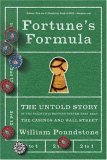Money Management, Kelly Criterion and the Stock Market
It all starts with a simple game:
A coin has 80% chance of flipping a HEAD and 20% chance of flipping a tail. At each turn of the game you place a bet. If the coin flips a HEAD, you get back twice the amount you bet. If the coin flips a TAIL, you lose your bet.
You have $10 available for betting, and you can play as many turns as you can afford.
The question is: Would you play this game? If so, how would you play it?
Although you have an edge in winning each turn, without proper money management you will eventually lose. Why? Because when you play long enough, you will run into a streak of bad turns and lose all your money. It is just probability.
So how can you systematically exploit this edge? Many money management systems can solve this problem. My personal favorite is the Kelly Criterion. It is the percentage of your bank roll that you should bet which will give you the highest long term geometric mean of return.
To see this mathematically, let’s define some variables:
F = % of the money available for betting
W1 = Return on investment (ROI) if you win: 100%
P1 = Probability of Winning: 80%
W2 = Return on investment (ROI) if you lose: -100%
P2 = Probability of Losing: 20%
B(0) = Initial amount available for betting (bank roll): $10
B(N) = Future bank roll after N turns
M = Geometric mean of return of N turns
With the above definition, we can formulate:
B(N) = B(0) * (1 + W1 * F)^(P1 * N) * (1 + W2 * F)^(P2 * N)
M^N = B(N)/B(0) = (1 + W1 * F)^(P1 * N) * (1 + W2 * F)^(P2 * N)
M = [(1+W1*F)^(P1*N) * (1+W2*F)^(P2*N)]^(1/N)
M = (1+W1*F)^(P1) * (1+W2*F)^(P2)
To maximize M, we can maximize the natural log of M:
Ln(M) = Ln[(1+W1*F)^(P1) * (1+W2*F)^(P2)]
Ln(M) = P1*Ln(1+W1*F) + P2*Ln(1+W2*F)
The above equation is what Ed Thorp stated in chapter 7 of his paper “THE KELLY CRITERION IN BLACKJACK, SPORTS BETTING, AND THE STOCK MARKET”, in which he discusses how to apply the Kelly Criterion in the stock market.
For our example, which has only two outcomes, the solution for the maximization is:
F = [W1*P1 – P2] / (1+W1) = 60%
This means you should bet 60% of your available bank roll each turn.
In the investment world (ie. stock market), the problem becomes more complicated as you might have more than two outcomes. For example, you might have:
Stock X is going to launch new products.
If product A is launched, ROI = 40% (probability = 40%)
If product B is launched, ROI = 20% (probability = 20%)
If product C is launched, ROI = 30% (probability = 30%)
If no products are launched, ROI = -80% (probability = 10%)
What percentage of your money should you invest in X?
It is mathematically difficult to find a formula to apply for such problems. However, you can use a free web Kelly calculator at: http://www.cisiova.com/betsizing.asp
To learn more about the Kelly Criterion and Money Management, I recommend you to read “Fortune’s Formula” by William Poundstone.
